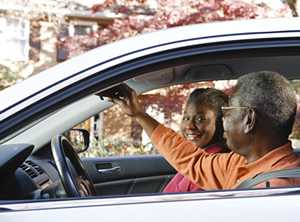Older Adult Drivers
In 2015, there were more than 40 million licensed drivers ages 65 and older in the United States.1 Driving helps older adults stay mobile and independent. But the risk of being injured or killed in a motor vehicle crash increases as you age. Thankfully, there are steps that older adults can take to stay safer on the roads.
 How big is the problem?
How big is the problem?
- In 2014, more than 5,700 older adults were killed and more than 236,000 were treated in emergency departments for motor vehicle crash injuries. This amounts to 16 older adults killed and 648 injured in crashes on average every day.2,3
- There were more than 40 million licensed older drivers in 2015, which is a 50 percent increase from 1999.1, 4
Who is most at risk?
- Involvement in fatal crashes, per mile traveled, begins increasing among drivers ages 70‒74 and are highest among drivers ages 85 and older. This trend has been attributed more to an increased susceptibility to injury and medical complications among older drivers rather than an increased risk of crash involvement.5
- Across all age groups, males have substantially higher death rates than females.5
- Age-related declines in vision and cognitive functioning (ability to reason and remember), as well as physical changes, may affect some older adults’ driving abilities.6
How can older driver deaths and injuries be prevented?

Older adults can take several steps to stay safe on the road.
Existing protective factors that may help improve older drivers’ safety include:
High incidence of seat belt use
While 60% of passenger vehicle occupants (drivers and passengers) ages 65-74 and 69% of passenger vehicle occupants ages 75+ killed in crashes were wearing seat belts at the time of the crash, seat belt use among younger adults ranged from 38% (among those ages 21-24) to 55% (among those ages 55-64).7
Tendency to drive when conditions are the safest
Older drivers tend to limit their driving during bad weather, at night, and on high-speed roads, in comparison to younger drivers.8
Lower incidence of impaired driving
Older adult drivers are less likely to drink and drive than other adult drivers.9 In 2015, only 6% of drivers ages 75+ years involved in fatal crashes had a blood alcohol concentration (BAC) of 0.08 grams per deciliter (g/dL) or higher, compared to 28% of drivers ages 21-24 years. Overall, 20% of drivers, regardless of age, involved in fatal crashes had a BAC of 0.08 g/dL or higher.10
Steps to Stay Safe on the Road
Older adults can take several steps to stay safe on the road, including:
- Exercising regularly to increase strength and flexibility.
- Asking your doctor or pharmacist to review medicines–both prescription and over-the counter–to reduce side effects and interactions.
- Having eyes checked by an eye doctor at least once a year. Wear glasses and corrective lenses as required.
- Driving during daylight and in good weather.
- Finding the safest route with well-lit streets, intersections with left turn arrows, and easy parking.
- Planning your route before you drive.
- Leaving a large following distance behind the car in front of you.
- Avoiding distractions in your car, such as listening to a loud radio, talking on your cell phone, texting, and eating.
- Considering potential alternatives to driving, such as riding with a friend or using public transit, which you can use to get around.
Publications
- Bergen G, West BA, Luo F, Bird DC, Freund K, Fortinsky RH, Staplin L. How do older adult drivers self-regulate? Characteristics of self-regulation classes defined by latent class analysis. Journal of Safety Research. 2017.
- Bird DC, Freund K, Fortinsky RH, Staplin L, West BA, Bergen G, Downs J. Driving self-regulation and ride service utilization in a multicommunity, multistate sample of U.S. older adults. Traffic Injury Prevention. 2017; 18:267-272.
Additional Resources
- NIOSH: Older Drivers in the Workplace: How Employers and Workers Can Prevent Crashes
- University of Michigan, Transportation Research Institute: Driving Decisions Workbook
- AAA Foundation for Traffic Safety: Senior Driver Web Site
- AAA National: AAA Roadwise Review: A Tool to Help Seniors Drive Safely Longer
- National Highway Traffic Safety Administration: Active Aging Programs
- AARP: Driver Safety Program
- Community Transportation Association of America: Senior Transportation
- Rides In Sight: https://www.ridesinsight.org/
References
- Federal Highway Administration, Department of Transportation (US). Highway Statistics 2015. Washington (DC): FHWA; September 2016.[cited 2016 Dec 21]. Available from URL: https://www.fhwa.dot.gov/policyinformation/statistics/2015/dl20.cfm
- Centers for Disease Control and Prevention, National Center for Injury Prevention and Control. Web-based Injury Statistics Query and Reporting System (WISQARS). Atlanta, GA: CDC; 2016 [cited 2016 Dec 21]. Available from URL: https://www.cdc.gov/injury/wisqars/index.html
- National Highway Traffic Safety Administration, Department of Transportation (US). Traffic Safety Facts 2014: Older Population. Washington (DC): NHTSA; May 2016 [cited 2016 Dec 21]. Available from URL: https://crashstats.nhtsa.dot.gov/Api/Public/ViewPublication/812273
- Federal Highway Administration, Department of Transportation (US). Highway Statistics 1999. Washington (DC): FHWA. [cited 2016 Dec 21]. Available from URL: http://www.fhwa.dot.gov/ohim/hs99/tables/dl20.pdf
- Insurance Institute for Highway Safety (IIHS). Fatality facts 2015, Older people. Arlington (VA): IIHS; November 2016. [cited 2016 Dec 21]. Available from URL: http://www.iihs.org/iihs/topics/t/older-drivers/fatalityfacts/older-people/2015
- Owsley C. Driver Capabilities in Transportation in an Aging Society: A Decade of Experience. Technical Papers and Reports from a Conference: Bethesda, MD; Nov. 7–9, 1999. Washington, DC, Transportation Research Board; 2004.
- National Highway Traffic Administration, Department of Transportation (US). Traffic Safety Facts 2014: A Compilation of Motor Vehicle Crash Data from the Fatality Analysis Reporting System and the General Estimates System. Washington (DC): NHTSA; 2016 [cited 2016 Dec 21]. Available from URL: https://crashstats.nhtsa.dot.gov/Api/Public/ViewPublication/812261 .
- Naumann RB, Dellinger AM, Kresnow MJ. Driving self-restriction in high-risk conditions: how do older drivers compare to others? J Safety Res 2011;42:67-71.
- Quinlan KP, Brewer RD, Siegel P, Sleet DA, Mokdad AH, Shults RA. Alcohol–Impaired Driving Among U.S. Adults: 1993–2002. American Journal of Preventive Medicine 2005;28:346–50.
- National Highway Traffic Safety Administration, Department of Transportation (US). Alcohol-impaired driving, 2015 data. Washington (DC): NHTSA; December 2016 [cited 2016 Dec 21]. Available from URL: https://crashstats.nhtsa.dot.gov/Api/Public/ViewPublication/812350.
- Page last reviewed: April 7, 2017
- Page last updated: April 7, 2017
- Content source:
- Centers for Disease Control and Prevention,
- National Center for Injury Prevention and Control,
- Division of Unintentional Injury Prevention


 ShareCompartir
ShareCompartir
